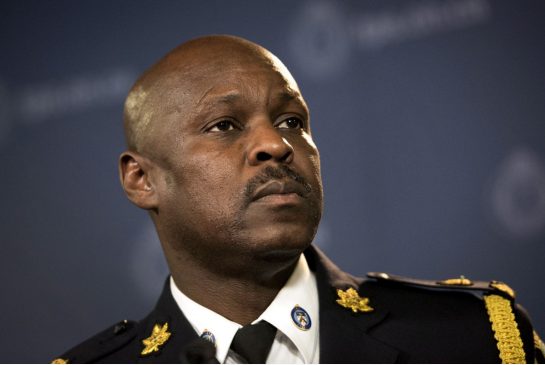
The Toronto Police Services Board has picked Mark Saunders as its new chief. Saunders, a deputy chief and the officer in charge of the TO2015 Pan Am Games, will take over from Bill Blair, who is set to retire at the end of this week. Saunders “represented the best choice among excellent choices” available to replace Blair, Mayor John Tory said at a Monday morning news conference.
The married father of four will be the city’s first black police chief, stepping into the role during a turbulent time between the force and some minority communities. Blair oversaw the implementation of the city’s controversial carding policy, which allows officers to collect information from residents even if they have committed no offence.
The chief designate spoke about the importance of good relations with the city’s many cultural communities.
“[They] deserve … a police force that is bias-free and whose members treat everybody with respect and dignity,” Saunders told reporters.
“You have my promise that I’ll do everything in my power to provide that. Community relationships determine the success or failures of our service. I do not take this lightly.”
The carding policy was originally part of a community outreach program intended to improve ties between the police service and marginalized communities. The effect has largely been the opposite, spurring greater distrust and forcing police to re-evaluate the policy altogether.
Members of the police board have expressed a desire to have the city’s diversity reflected among the top echelon of the police command structure.
But Saunders, 52, made it clear he didn’t consider himself a token appointment, stressing that he is eminently qualified for the job.
“Being black is fantastic, it doesn’t give me super powers,” he joked. “If you’re expecting that all of a sudden that the earth will open up and miracles will happen, that’s not going to happen.”
Homicide unit veteran
Saunders has had a 32-year career with Toronto police, working with the force’s gang and drug squads and overseeing the homicide division — one of the largest in Canada.
He currently heads the special operations command with its 1,200 officers and 164 civilians, which includes the homicide squad, sex-crimes unit, and guns and gangs task force.
According to his police biography, Saunders also created the force’s investigative cybercrime unit, known as “C3,” and was one of the authors of the “Police and Community Engagement Review,” now commonly known as the PACER report.
The report largely endorsed carding as a valuable policing tool, drawing backlash from community advocates and organizers.
Peter Sloly, the force’s other deputy chief and contributor to the PACER report, was considered the other front runner for police chief.
‘Real change’
Alok Mukherjee, the head of the police services board, called Saunders a credible and inspiring leader who is expected to bring “real change.”
Saunders, whose children range in age from 10 to 26, was born in the U.K. to Jamaican parents and immigrated to Canada as a child.
Saunders said the implications of his appointment as the first black to lead the force only sank in during a chat with his 10-year-old son.
“He said to me, ‘You know, Dad, that’s history and that’s something they can never take away from you’,” Saunders said. “If it offers any hope to anybody that is a person of colour that feels that this gives them hope, then I’m glad that it does.”

